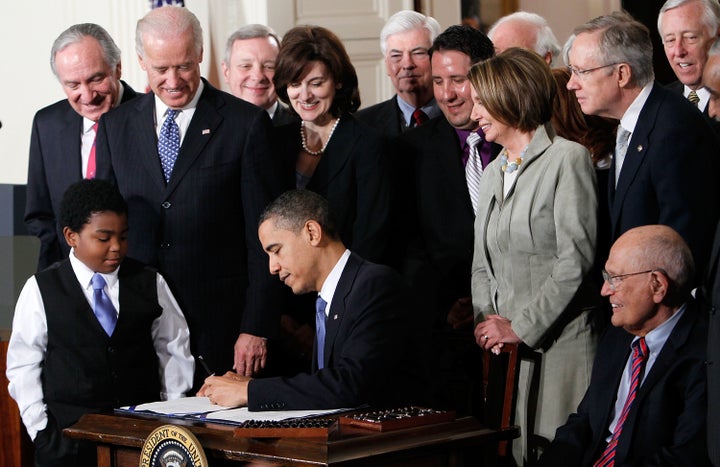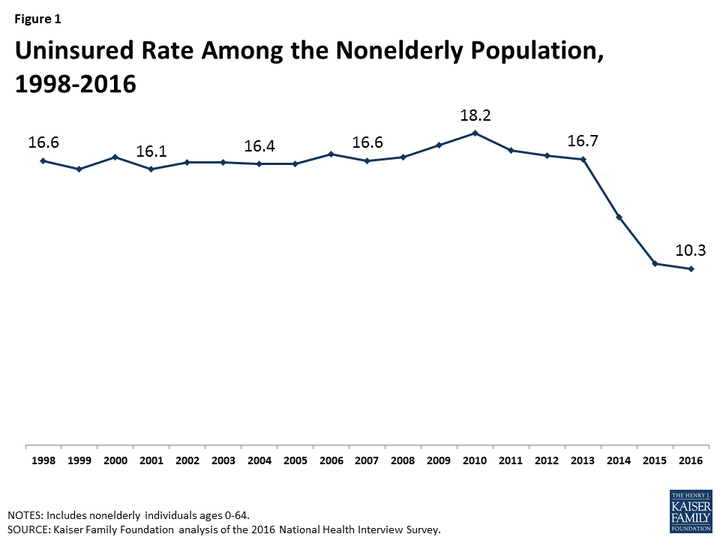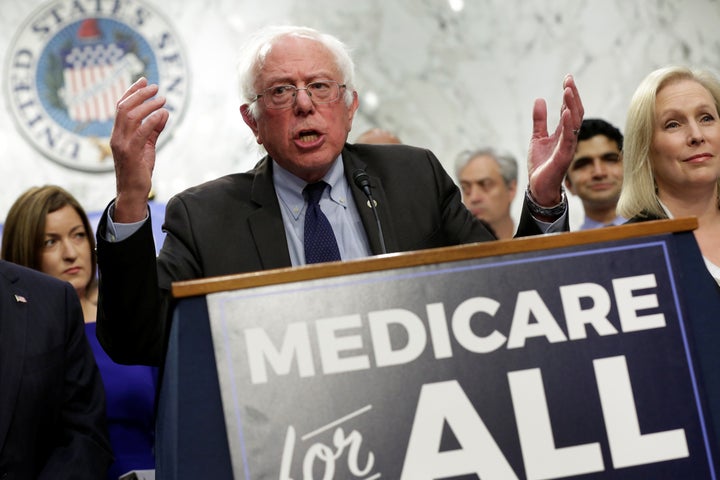President Barack Obama signed the Affordable Care Act into law on March 23, 2010 ― eight years ago Friday. But this anniversary feels different from the ones that came before it.
In the past, Democrats have been preoccupied with implementing the law and fending off efforts to destroy it. That was especially true last year, when President Donald Trump and his Republican allies came within a single senator’s vote of passing repeal legislation.
Now the political environment is different. Republicans have not given up on repeal, but their assault on the law has made it more popular than ever. Meanwhile, the midterm elections are approaching. For the first time since 2010, Democrats could have governing majorities in one or even both houses of Congress ― and, two years after that, control of the White House as well.
The shift means that Democrats can focus more on the conversation they wanted, and were trying to have, all along. It’s the conversation about how to fix the Affordable Care Act’s shortcomings, in order to realize its ultimate goal of universal coverage.

One sign of the shifting debate came on Tuesday, when Sen. Elizabeth Warren from Massachusetts became the latest high-profile Democrat to introduce a bill to upgrade the Affordable Care Act ― in this case, by offering more financial assistance to people buying insurance on their own and bolstering the law’s consumer protections.
Warren was also among nearly two dozen Democrats who, back in January, stood alongside Bernie Sanders, the independent senator from Vermont, when he introduced a proposal that would wipe out private insurance and create, in its place, a program like Medicare that would enroll all Americans.
In unveiling his bill, Sanders (who co-sponsored Warren’s bill as well) was simply introducing a new variation on an idea he has touted for years and, famously, made the centerpiece of his 2016 presidential campaign. But it was the first time he got support from so many of his colleagues, including, conspicuously, pretty much every Democratic senator thinking about a White House bid in 2020.
Liberal think tanks are likewise putting new muscle into policy proposals. The Center for American Progress in February released a plan that would also create a Medicare-like government program. It’s the most ambitious proposal the center has released since back in 2008, when it was writing white papers destined to become blueprints for the Obama administration.
And just a few weeks before that, the Century Foundation and American Prospect magazine ― both well-known incubators of ideas Democratic officials end up using ― convened a Washington, D.C., conference. It included some of the most influential liberal policy experts. The goal was to begin hashing out the details of plans for improving or replacing the system the Affordable Care Act has created, on the theory that opportunities to pass ambitious legislation may not be far away.
The Ideas Haven’t Changed, But The Political Environment Has
None of the proposals under discussion are especially new. Most have been around since long before the phrase “Obamacare” was even part of the lexicon.
As president, Obama promoted many of them as ways to make his signature legislative accomplishment work better. As a candidate in 2016, Hillary Clinton proposed a $250 billion plan that would have helped people struggling with premiums and out-of-pocket expenses, much like Warren’s plan would.
But even Clinton’s proposal had a wistful feel to it, given that Republicans were all but certain to hold one house of Congress, blocking anything that smacked of “helping Obamacare.” When Clinton lost to Trump, it looked like the law’s days were numbered, rendering discussion of improvements moot.

As it happens, the GOP’s effort to undo the law’s accomplishments ended up demonstrating just how popular those accomplishments are. Millions of people have insurance they couldn’t get before, because they couldn’t afford it or because they had pre-existing conditions. Americans may not be thrilled with Obamacare, but they have no appetite for giving up those gains.
The backlash was strong: Polls showed GOP repeal proposals were among the most unpopular legislative efforts in decades. And it doesn’t look like the voters haven’t forgotten. It is almost certainly a big reason the electoral prospects for Democrats look as promising as they do.
GOP Sabotage Exposed Some Of Obamacare’s Vulnerabilities
The Affordable Care Act’s architects always expected to revisit health care. They understood the law would not fix all of the problems in the U.S. health care system ― and that it would create some new ones along the way. Still, they hoped to create a program that would run smoothly, make coverage available to most residents and prove broadly popular.
It worked out that way in states like California and Michigan, but not in states like North Carolina and Tennessee ― states where insurers over the last few years have jacked up premiums or dropped out of the markets altogether because they were losing so much money. In many of those same states, millions of low-income people remained uninsured, because officials have not made Medicaid available to them.
An obstacle to progress in these states has been ambivalence, or outright hostility, from Republican state officials in charge of implementation. It is GOP politicians who, taking advantage of leeway they got from a Supreme Court decision, have refused to expand their Medicaid programs as the Affordable Care Act’s architects had intended. It is GOP officials who have declined to promote enrollment aggressively.

Republicans in Washington, D.C., have also done their part to undermine the law. Marco Rubio, the GOP senator from Florida, led a successful crusade to pull funding from the Affordable Care Act’s “risk corridor” program, which was supposed to insulate insurers from big losses in the early years of implementation. Some insurers took big losses as a result, and a few even shut down.
These efforts have gotten even more intense since Trump took office. His administration has pulled funds for enrollment outreach and proposed regulatory changes that, experts say, will undermine guarantees of coverage for pre-existing conditions. Late last year, Republicans passed ― and Trump signed ― a tax bill that eliminates the penalty for people who don’t buy insurance.
Without that penalty in place, healthy people are less likely to get coverage. That will cause yet more problems for insurers, who will respond in the same way they have before: by raising rates or pulling out of markets altogether.
Trump and the Republicans have all but admitted they are trying to sabotage the program. Their efforts appear to be paying off.
The Price Of Past Democratic Compromises Is More Apparent
And yet ― these efforts might not have such a big effect if the coverage available under the Affordable Care Act were more affordable in the first place. For many Americans, it hasn’t been. One reason is the decisions Democrats made when they wrote the law.
Health care in the U.S. is so expensive that comprehensive insurance, the kind generous enough to provide real protection from medical bills, is costly even for most middle-class families. A typical employer policy for a family costs nearly $19,000, according to last year’s HRET/Henry J. Kaiser Family Foundation annual study, although few Americans realize it because employers are paying most of the bill directly.
On a per-person basis, this is way more than health care costs in any other country. Closing that gap was a major focus of the Affordable Care Act, which ratcheted down what Medicare pays hospitals and introduced incentives for higher quality, but less costly, care. It was part of a broader effort to push the health care system in the direction of more efficiency, in the hopes that more efficient care would also be less expensive.

The law’s architects understood that process would take time, however. That’s one reason they were determined to make private coverage more affordable the right away ― by offering people tax credits to offset the cost of premiums and, in some cases, out-of-pocket costs.
That arrangement has mostly worked for people with incomes below 250 percent of the poverty line, which works out to $62,750 a year for a family of four. For them, the tax credits are so generous that insurance is well within reach ― and sometimes even free! (The ones who have incomes above or just below the poverty line can simply enroll in Medicaid, as long as their state has expanded eligibility.)
But federal assistance tapers off at higher incomes and cuts out entirely at four times the poverty line, or $100,400 for a family of four. People getting little or no assistance can really struggle to pay for insurance. That’s especially true for older consumers because insurers still have some leeway to charge them higher premiums. In the most extreme cases, insurance costs these people 20 percent of their income or more, not including out-of-pocket expenses.
Early versions of the legislation Democrats debated in 2009 and 2010 envisioned subsidies that were both more generous and available to more people. Had that kind of legislation passed, many fewer people would be struggling with premiums today.
But Democrats scaled back the assistance to reduce the overall price of the bill, in an effort to appease more conservative lawmakers as well as more conservative voters ― and to follow through on a pledge, which Democrats had made, that the law would pay for itself.
The health care law’s architects also backed off some of the most aggressive proposed cuts to the health care industry, in order to keep those groups from using their lobbying power to block the bill’s passage. This included a decision to drop the public option, which not just insurers but also hospitals and doctors opposed because it would pay them less money.
Politically, the strategy worked as intended. Most of the health care industry supported the bill, or at least didn’t fight it. But it meant that their prices wouldn’t be coming down much, keeping insurance prices high.
Democrats Have A Lot Of Work To Do
The proposals getting attention today address these problems directly. Some call for making subsidies available to all people buying coverage on their own, so that nobody has to pay more than a fixed portion of their income. (In Warren’s bill, the cap is 8.5 percent of income.) Other proposals envision new twists on the public option, like opening up Medicaid to people who can’t find private coverage that fits their budgets.
Some plans envision government setting prices directly, not just for drug and device makers but for doctors and hospitals too. This is what most developed countries do, and it’s the main reason health care in those countries is so much less expensive than it is in the U.S.
The most ambitious of the schemes circulating now are the single-payer proposals. They include all of the elements Democrats are discussing: more generous financial assistance, federally administered insurance and government-set prices. If fully implemented, they would create a health care system that strongly resembles some of the universal systems abroad.

A key question for Democrats is whether the different approaches they are discussing have to be mutually exclusive. In principle, once the more incremental changes are in place, they can provide a platform for creating something more comprehensive. If the federal government is already setting drug prices, for instance, it’s less of a leap ― as politics and as policy ― to have it set prices for doctors and hospitals too.
Still, if Democrats get a chance to start legislating, they will have to make choices about emphasis and political strategy. Do they insist on single-payer or something close to it, negotiating back from that? Or continue to push hard for more incremental measures?
At some point, Democrats will also have to confront divisions within their own ranks. Some conservative Democrats cannot accept a system in which government provides everybody, or even most people, with insurance. Some liberal Democrats cannot accept a system in which for-profit insurers still have a significant role. Those two views are fundamentally incompatible.
Nor is the conversation about health care reform ultimately one Democrats can have on their own. Every idea now popular among Democrats has real potential to make medical care more accessible and more affordable. But every idea also comes with its own trade-offs.
More generous subsidies would mean more federal spending. Dramatically cutting revenues for any health care industry group would cause closures and job losses, potentially making it harder for patients to get care. Pushing everybody into public insurance would force some to give up private insurance they like.
Promoters of these new policies rarely acknowledge these trade-offs. It’s an open question whether most have thought through the consequences of what they propose, or formulated arguments to rebut serious criticism. That’s why the conversation now underway is so important. If Democrats want to legislate someday, they need to be ready.

